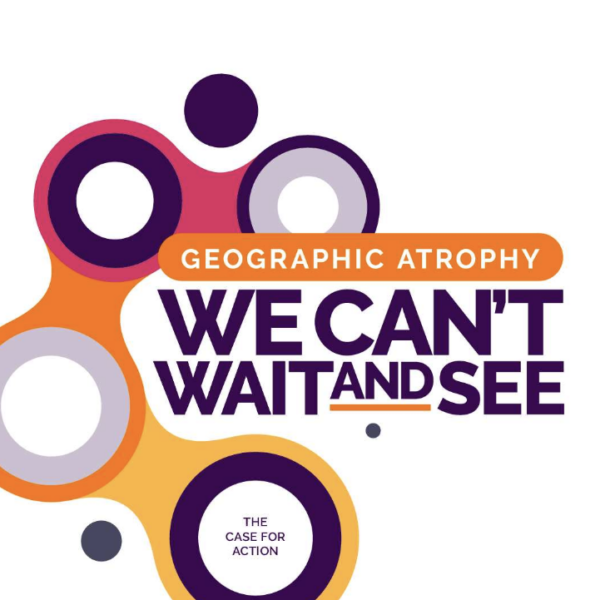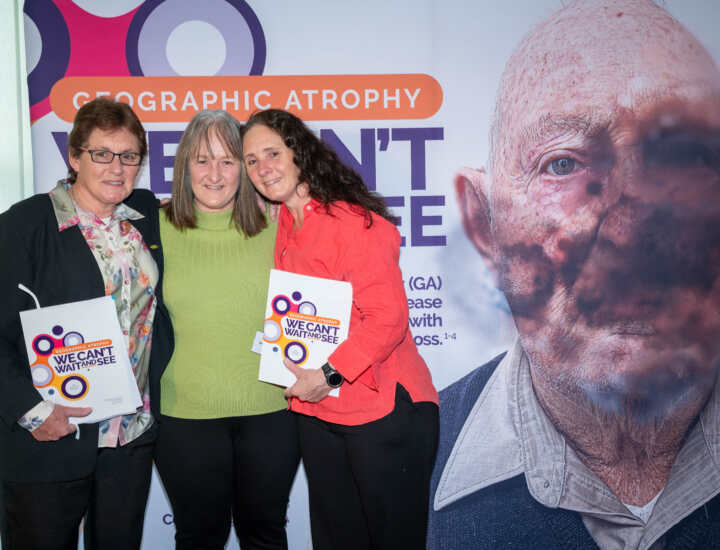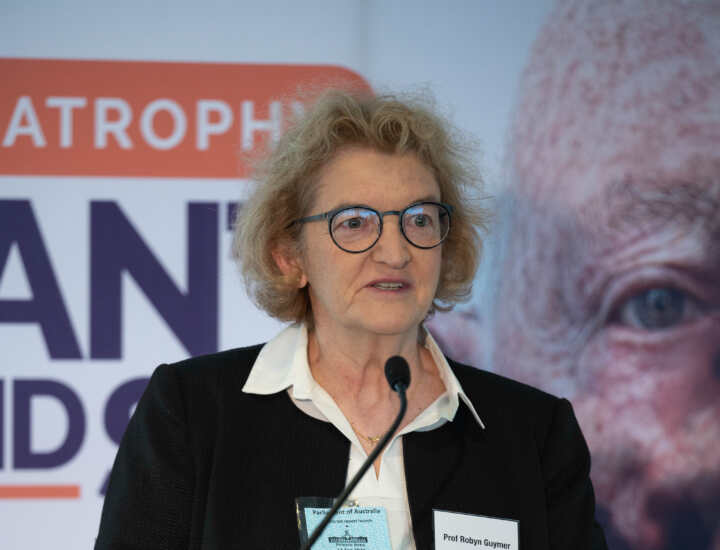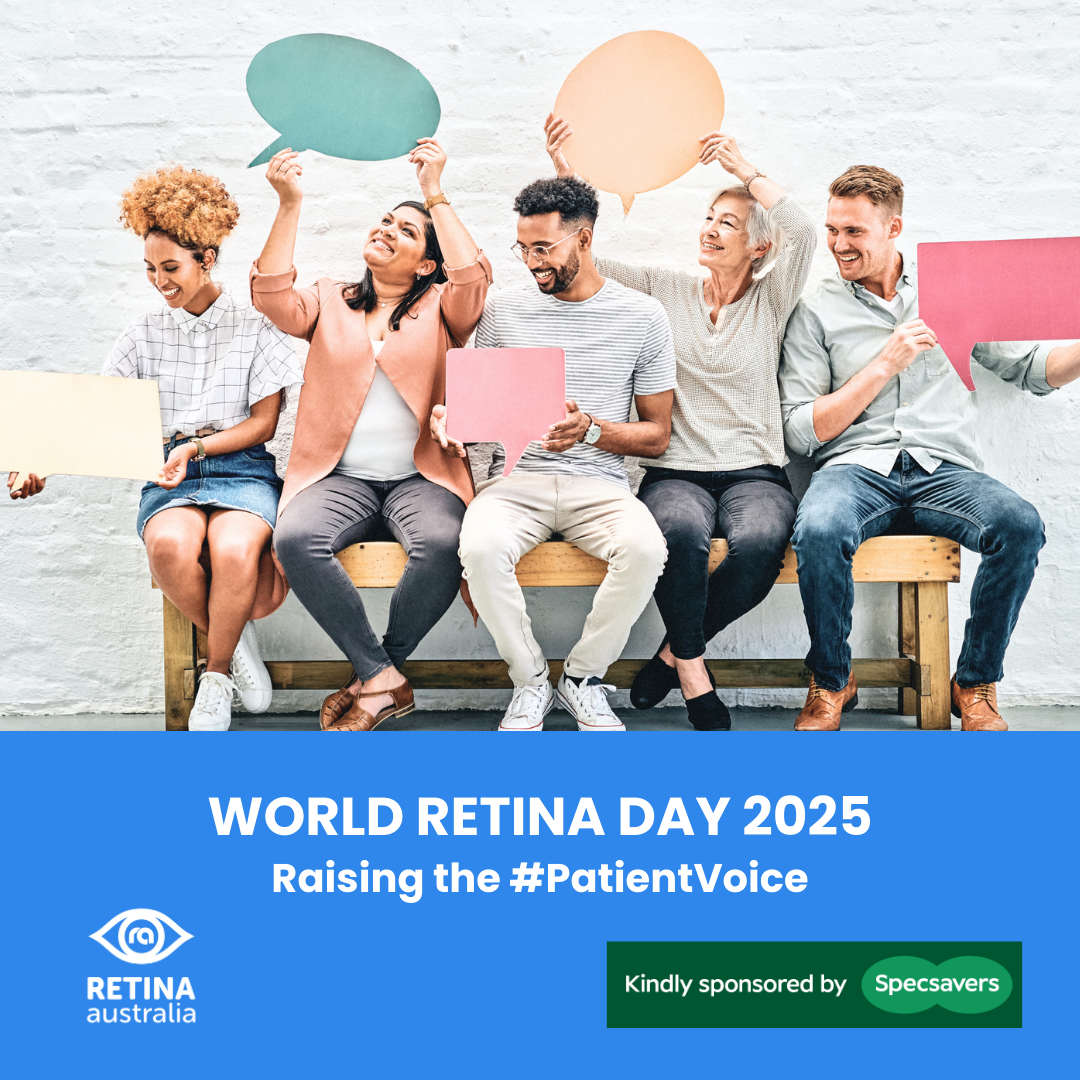16 September, 2024
The Case for Action
Geographic Atrophy: We Can’t Wait and See is a report that highlights the urgent need to address the impact of geographic atrophy (GA), a progressive retinal dystrophy which is one of the leading causes of loss of vision and blindness.
The report presents study findings from both a financial analysis and a Social Return on Investment (SROI) perspective to provide a full representation of the total GA burden to the community.
This report was officially launched at Parliament House in Canberra on Tuesday 11 September 2024 hosted by The Parliamentary Friends for Eye Health and Vision Care, led by Co-chairs Ms Meryl Swanson MP and Dr David Gillespie MP.
Retina Australia was a member of the Advisory Committee for the development of the report, along with other leading organisations in the eye heath and vision care sector – Macular Disease Foundation Australia (MDFA), Optometry Australia, Sight For All, Vision Australia and Vision 2020 Australia. The study was conducted by HTANALYSTS, report prepared by Crash Bang Wallop, sponsored by Apellis Australia.

Report Summary
Vision is a one of our key senses, and its loss, particularly from conditions like geographic atrophy (GA), can significantly impact quality of life, independence, and overall wellbeing.
GA is an advanced form of age-related macular degeneration (AMD) that can affect individuals from age 50 but more commonly over 65, leading to irreversible central vision loss as cells in the macula die. The disease can result in legal blindness in about 20% of cases, affecting the ability to perform everyday tasks like reading, driving, and recognising faces.
Australia’s ageing population makes it essential to address vision loss, which has a social and economic cost.
The financial burden of GA-related vision loss in Australia exceeds $1.8 billion annually, including $377.23M in direct healthcare costs, $312.74M in indirect healthcare costs and $1,112.49M in wellbeing costs.
Investing in interventions to delay vision loss offers a substantial social return on investment (SROI), with $2.21 of social value created for every $1 invested.
Key report recommendations include:
- Equitably funding vision support services for older Australians to maintain independence and quality of life.
- Raising awareness of GA and the importance of early detection through a national campaign.
- Providing public funding for Optical Coherence Tomography (OCT) imaging to detect and monitor GA.
- Creating a national AMD registry to track the true burden of GA.
- Securing dedicated research funding to better understand and treat GA.
- Ensuring timely access to new GA therapies once approved to prevent further vision deterioration.
These actions are essential to reduce the social, emotional, and economic burden of vision loss in the elderly population.
Report Details
The Significance of Vision and Its Loss
Vision enables individuals to connect socially with friends and family and also with their environment. Losing this ability can significantly impair independence, mental health, and quality of life. For many, vision loss often leads to a profound psychological toll, as people struggle to adapt to their new reality. Simple tasks such as reading, driving, recognising faces, and navigating familiar environments become difficult or impossible, leading to increased dependency on others and, in many cases, isolation.
For those who have experienced vision loss, the sense of being cut off from the world is overwhelming. The report shares personal testimonials from patients and their carers, highlighting how GA can alter lives, erode independence, and affect social relationships. Often, individuals with vision loss struggle with loneliness and depression as they are unable to engage in the activities that once defined their lives. Moreover, carers and family members also experience emotional and financial strains as they take on the increased responsibility of supporting their loved ones.
Colin and the Wilmott family share the impact of GA on their lives
Video source: Crash Bang Wallop
Understanding Geographic Atrophy (GA)
GA is a chronic, degenerative condition that primarily affects older adults. It is the dry form of advanced AMD, a leading cause of blindness in individuals over the age of 65. As the disease progresses, the cells in the macula—the central part of the retina responsible for sharp vision—begin to die. This results in patches of missing retina, leading to irreversible vision loss.
Early in the disease, GA lesions often develop away from the fovea (the central area of the retina where vision is clearest), which allows individuals to compensate for the vision loss without significant disruptions to their daily lives. However, as the disease progresses, the lesions expand and eventually encroach on the fovea. At this stage, individuals experience more pronounced vision impairment, which severely limits their ability to perform essential activities like reading, driving, and recognising faces. When both eyes are affected, the loss of central vision is even more debilitating.
The most severe stage of GA can result in legal blindness in approximately 20% of cases, leaving individuals unable to navigate their environment independently. Legal blindness is defined as visual acuity worse than 20/200 or a visual field of less than 20 degrees, significantly limiting a person’s functional vision. This progression highlights the critical need for early detection and interventions that can delay the onset of severe vision loss.
The Ageing Population and the Growing Burden of GA
As the population ages, GA presents a growing public health challenge. In Australia, one in six individuals is over the age of 65, and as life expectancy continues to rise, the number of people living with age-related health conditions, including GA, will increase. It is estimated that between 75,000 and 100,000 Australians currently live with GA, though the exact number remains difficult to determine due to underdiagnosis and the lack of available treatments.
For older adults, maintaining good health, independence, and social connections is vital for a high quality of life. Vision loss significantly threatens these factors, making it an economic and social imperative to address GA. The loss of vision not only diminishes an individual’s quality of life but also places a considerable strain on government services such as healthcare, aged care, and welfare systems. Moreover, people living with GA often believe that declining vision is a natural part of ageing, which leads to delays in seeking treatment or diagnosis. However, with emerging treatments on the horizon, there is a need for increased awareness and preparedness to address GA effectively.
The Financial Burden of GA in Australia
The economic cost of vision loss from GA in Australia is substantial. This study revealed that the total financial cost exceeds $1.8 billion annually. This includes direct healthcare costs, such as specialist appointments and eye imaging, as well as non-health system costs like transportation and home modifications. Moreover, the loss of wellbeing associated with GA-related vision loss accounts for $1.1 billion of the total cost. Patients with GA bear a significant portion of these costs through out-of-pocket expenses, including aged care services, mental health support, and adaptive aids required for everyday functioning.
Beyond the direct financial costs, the loss of vision due to GA can lead to reduced productivity, increased dependence on government support, and a higher incidence of accidents such as falls, burns, and road traffic incidents. These factors not only result in higher healthcare costs but also contribute to a decreased quality of life for individuals affected by GA and their families.
The Social Return on Investment (SROI) for GA Interventions
The Social Return on Investment (SROI) analysis underscores the potential societal and economic benefits of investing in interventions to delay vision loss and prevent legal blindness due to GA. The analysis shows that for every $1 invested in such interventions, $2.21 of social value is created. This value is derived primarily from maintained independence (55%) and improved social and emotional outcomes (45%), with less than 1% of the value being economic in nature.
Maintained independence is a crucial outcome of delaying vision loss, as it enables individuals to continue performing daily tasks such as driving, cooking, and reading, which are essential for sustaining quality of life. Moreover, independence reduces the need for expensive aged care services and alleviates the emotional and financial burden on carers. The SROI also highlights the broader social impact of GA interventions, particularly the positive effects on mental health, social connections, and emotional wellbeing.

The majority of the benefits from GA interventions are experienced by individuals living with the condition (82%), followed by their carers (17%). Carers, often family members, face significant challenges, including increased responsibility for daily care and support. By delaying vision loss, these interventions can ease the emotional strain on carers and allow them to maintain employment and social engagement, further contributing to the overall social value of the investment.
Key Recommendations to Address GA
Given the significant impact of GA on individuals, carers, and the broader healthcare system, the Geographic Atrophy: We Can’t Wait and See report proposes several key recommendations to mitigate the burden of vision loss and improve outcomes for those affected by GA:
1. Equitably Fund Vision Support Services for Older Australians
Individuals experiencing vision loss due to GA should have equitable access to support services that help them maintain their independence and dignity. These services include information and education, mental health support, practical aids, home modifications, and social support groups to combat isolation. However, there is currently a funding gap between those eligible for the National Disability Insurance Scheme (NDIS) and those who rely on aged care funding, disadvantaging some individuals. Closing this funding gap would ensure that everyone, regardless of age, has access to the necessary vision support services.
2. Raise Awareness and Promote Early Detection of GA
There is a significant need for a national awareness campaign to educate the public about GA and the importance of regular eye examinations, particularly for older Australians. A campaign led by a prominent eye health organisation would increase the number of people seeking eye checks, leading to earlier detection of GA and other vision conditions. Early detection is crucial in preventing severe vision loss and improving outcomes for individuals living with GA.
3. Provide Public Funding for OCT Imaging
Optical Coherence Tomography (OCT) is a vital diagnostic tool for detecting and monitoring GA. However, OCT imaging is not currently funded through the public health system for conditions without available treatments, leaving many patients unable to afford the scans. Public funding for OCT imaging, particularly for individuals over 50, would enable earlier diagnosis and better disease management, reducing the long-term burden on the healthcare system.
4. Establish a National AMD Registry
There is an urgent need to establish a national registry to capture data on the prevalence and progression of GA in Australia. This registry would enable researchers and healthcare providers to assess baseline disease characteristics, monitor disease progression, and inform treatment and support services. A coordinated approach to data collection would also provide valuable insights into the effectiveness of interventions and help ensure that patients are ready for treatment when new therapies become available.
5. Invest in GA Research
Continued investment in GA research is critical for advancing the understanding of the disease and developing effective treatments. Funding through national programs such as the Medical Research Future Fund (MRFF) and the National Health and Medical Research Council (NHMRC) should prioritise GA research to accelerate the discovery of new therapies and identify patients most likely to benefit from treatment.
6. Ensure Timely Access to New GA Therapies
Delays in accessing new treatments can have devastating consequences for individuals with GA. In Australia, the average time between the registration of a new medicine by the Therapeutic Goods Administration (TGA) and its availability through the Pharmaceutical Benefits Scheme (PBS) is more than a year. For people with GA, this delay means further vision deterioration that cannot be reversed. As new treatments for GA are developed, fast-tracking funding and approval processes will be essential to prevent further harm and improve patient outcomes.

The Urgency of Taking Action
The significant impact of GA on individuals, their families, and the Australian healthcare system necessitates urgent action.
Presenting at the launch of the Geographic Atrophy: We Can’t Wait and See report at Parliament House in Canberra, Professor Robyn Gymer AM expressed the importance of diagnosing now ready to be ready for coming treatments.
By investing in early detection, providing equitable access to support services, and ensuring timely availability of new treatments, the burden of GA can be significantly reduced. Delaying vision loss and preventing legal blindness would not only improve the quality of life for those affected by GA but also create substantial social and economic value for the Australian community.
You can read the full Geographic Atrophy: We Can’t Wait and See report or an abridged version by clicking on the buttons below.
This article was sponsored by Apellis Australia.
https://retinaaustralia.com.au/geographic-atrophy-we-cant-wait-and-see/
Other Blogs

World Retina Day 2025
Every year, World Retina Day shines a spotlight on the millions of people living with inherited retinal diseases and other retinal dystrophies. These conditions affect not only vision, but...

World Research Summary by Dr Catherine Civil
Hot Off The Press Check out below to see what new inherited retinal disease (IRD) therapies are in the pipeline. I...

Have your say – First GA treatment being considered for PBS subsidy
Do you have geographic atrophy? If you or someone close...
